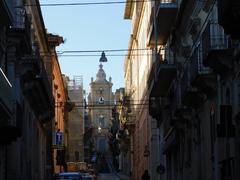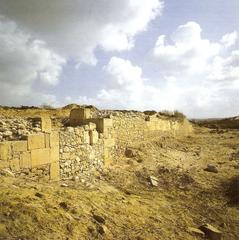Museo Civico Italia In Africa Ragusa: Visiting Hours, Tickets, and Historical Site Guide
Date: 14/06/2025
Introduction
Located in the heart of Ragusa, Sicily, the Museo Civico Italia In Africa invites visitors to explore a pivotal and often underrepresented chapter of Italian and African history. This museum is dedicated to examining Italy’s colonial past in Africa, with collections chronicling the country’s presence in Eritrea, Somalia, Libya, and Ethiopia from the late 19th century to the mid-20th century. Through carefully curated artifacts, documents, and multimedia, the museum sheds light on both the ambitions and legacies of Italian colonialism, while fostering critical reflection on the lasting impacts of this era.
This comprehensive guide provides all essential visitor information, including opening hours, ticketing details, accessibility, exhibit highlights, and practical travel tips. Whether you are a history enthusiast, a cultural traveler, or a student, the Museo Civico Italia In Africa is a key destination for meaningful engagement with both Italian history and Ragusa’s rich architectural heritage.
For the latest visitor information, see The World of Sicily, Comune di Ragusa, and Museionline.
Table of Contents
- Introduction
- Historical Background: Italian Colonialism in Africa
- Foundation and Development of the Museum
- Museum Layout and Collection Highlights
- Visitor Information: Hours, Tickets, and Accessibility
- Travel Tips and Nearby Ragusa Historical Sites
- Educational Initiatives and Ethical Considerations
- Frequently Asked Questions (FAQ)
- Conclusion and Further Resources
Historical Background: Italian Colonialism in Africa
Between 1882 and 1960, Italy established and managed four principal colonies in Africa: Eritrea, Somalia, Libya, and Ethiopia. This was part of the broader “Scramble for Africa,” during which European powers sought control over African territories. Italy’s colonial efforts began with the acquisition of Assab Bay (Eritrea) in 1882, later expanding to Somalia, Libya (following the Italo-Turkish War, 1911–1912), and Ethiopia (occupied in 1936 after the Second Italo-Ethiopian War). The colonial period ended with Italy’s defeat in World War II and subsequent loss of its territories (The World of Sicily).
The impacts of Italian colonialism were profound, affecting local societies, economies, and cultures, and leaving a legacy that continues to influence both Italy and its former colonies today.
Foundation and Development of the Museum
Museo Civico Italia In Africa was founded in Ragusa as a response to the need for critical engagement with Italy’s colonial history—an aspect often underrepresented in Italian public memory. The museum was established in 2009, largely through the efforts of Mario Nobile, who spent over 35 years collecting artifacts, documents, and memorabilia related to the Italian presence in Africa (Museionline). The collection was further enriched by donations from local families, veterans, and academic collaborations.
The museum not only preserves original artifacts but also strives to engage visitors in dialogue about colonialism’s complexities, its social and cultural impacts, and its ongoing legacy in contemporary society.
Museum Layout and Collection Highlights
The Museo Civico Italia In Africa is organized into four main areas, each dedicated to a former colony. This thematic structure allows for a chronological and comparative exploration of Italy’s colonial activities:
Eritrea Room
- Focus: Italy’s earliest colonial venture.
- Highlights: Uniform of an ascaro standard-bearer from the III Battaglione di Fanteria Eritrea “Galliano,” documents from the acquisition of Assab, photographs depicting Italian and Eritrean interactions.
Somalia Corridor
- Focus: Italian administration during both the colonial and UN mandate periods (1950–1960).
- Highlights: Uniforms, awards, photographs, and materials illustrating governance and local societal changes.
Libya Room
- Focus: Italian colonization of Libya and the experience of Italian settlers.
- Highlights: Mannequins depicting an Italian family preparing to depart for Libya, uniform of a Zaptie’ (Libyan gendarmerie) from the Governor’s escort, and artifacts from both military and civilian life.
Ethiopia Room
- Focus: The conquest and occupation of Ethiopia (1935–1941) and the creation of Italian East Africa.
- Highlights: The uniform and personal standard of Amedeo di Savoia, Duke of Aosta, Viceroy of Ethiopia, original propaganda materials, and items reflecting both Italian and Ethiopian perspectives.
Additional Features:
- Documents & Photographs: Letters, official decrees, period newspapers, and rare images.
- Objects of Daily Life: Household tools and personal items showcasing cultural exchanges and daily realities.
- Multimedia Installations: Interactive displays and oral histories, including the “Voices from the Colonies” installation which features testimonies from Italian and African descendants (RAI Cultura).
Visitor Information: Hours, Tickets, and Accessibility
- Opening Hours:
Typically Tuesday to Sunday, 9:00 AM–1:00 PM and 4:00 PM–7:00 PM. Closed Mondays and certain public holidays. Hours may vary seasonally—always verify via the official website. - Tickets:
Standard adult entry is €2–€5, with discounts for students, seniors, and groups. Children under 12 may enter free. Some days may offer free admission; check ahead for current pricing (Museionline). - Booking:
Tickets are available onsite and sometimes online. Advance booking is recommended during busy periods or for group/guided visits. - Accessibility:
The museum is located on the ground floor and is generally wheelchair accessible. Those requiring specific accommodations should contact the museum in advance. - Facilities:
Onsite restrooms, a small gift shop, and an information desk are available. Photography is usually permitted for personal use—ask staff for current policy.
Travel Tips and Nearby Ragusa Historical Sites
- Getting There:
The museum is centrally located and easily reached on foot from Ragusa Superiore or Ibla. Public transportation options include buses and taxis (The Road Reel). Parking may be limited—arrive early or use public transit. - Best Visiting Times:
Weekday mornings offer a quieter experience. Allow at least 1–2 hours for your visit. - Language:
Most displays are in Italian; guided tours or translation apps are suggested for non-Italian speakers. - Combine Your Visit:
Explore Ragusa’s renowned Baroque sites nearby:- Duomo di San Giorgio: Iconic Baroque cathedral.
- Giardino Ibleo: Panoramic public garden.
- Castello di Donnafugata: 19th-century castle outside the city.
- Ragusa Ibla: The city’s historic old town with picturesque streets (Go Ask a Local).
- Seasonal Tips:
Visit during shoulder seasons (April–June, September–October) for pleasant weather and fewer crowds (The Road Reel).
Educational Initiatives and Ethical Considerations
The Museo Civico Italia In Africa is committed to responsible and ethical curation. The museum follows international standards for the display of sensitive artifacts, consulting with African scholars and communities as appropriate (ICOM Code of Ethics). Educational programs include guided tours, workshops, and outreach to schools and diaspora communities, emphasizing critical engagement and dialogue.
The museum also participates in international conversations about restitution and the ethical treatment of colonial-era collections (UNESCO).
Frequently Asked Questions (FAQ)
Q: What are the Museo Civico Italia In Africa visiting hours?
A: Generally Tuesday to Sunday, 9:00 AM–1:00 PM and 4:00 PM–7:00 PM; closed Mondays and holidays. Always verify on the official site.
Q: Is the museum accessible for visitors with disabilities?
A: Yes, but contact the museum for specific accessibility needs.
Q: How can I buy tickets?
A: Tickets are available onsite and sometimes online. Booking ahead is recommended in peak periods.
Q: Are guided tours available?
A: Yes, by prior arrangement. Tours may be available in languages other than Italian.
Q: Can I take photos inside?
A: Photography for personal use is generally allowed; confirm with museum staff.
Q: What are recommended nearby attractions?
A: Duomo di San Giorgio, Giardino Ibleo, Ragusa Ibla, and Castello di Donnafugata.
Conclusion and Further Resources
The Museo Civico Italia In Africa is a must-visit for anyone interested in Italy’s colonial history, the complexities of intercultural encounters, and the enduring legacy of the past. Its rich collections, immersive exhibits, and commitment to ethical curation make it an essential stop in Ragusa’s vibrant cultural landscape.
Maximize your visit by checking current opening hours, booking tickets in advance, and combining your museum tour with Ragusa’s stunning historic sites. For more details, visitor tips, and updates on events and exhibitions, consult:
Stay connected by downloading the Audiala app for guided tours and up-to-date content, and follow local tourism channels for the latest news.
References
- The World of Sicily
- Museionline
- Comune di Ragusa
- The Road Reel
- RAI Cultura
- ICOM Code of Ethics
- UNESCO
- Go Ask a Local
- WhichMuseum
- The Guardian

